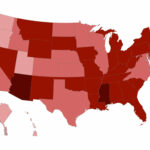The Centers for Disease Control and Prevention (CDC) reports that 1 in 4 adults aged 65 and above in the US experience at least one COVID-related symptom a year after their initial infection. For patients under the age of 65, the ratio is almost as bad at more than 1 in 5 adults suffering long COVID in the US.
“It is sobering to see the results of this study again confirming the breadth of organ dysfunction and the scale of the problem,” The New York Times quoted Dr. Ziyad Al-Aly, chief of research and development and clinical epidemiologist at Washington University in St. Louis.
Early data has shown that long-term effects such as kidney failure, neurological conditions, and mental illnesses are more likely for elderly persons. The new empirical evidence also found that a breakthrough infection is possible even in vaccinated individuals.
Respiratory symptoms and musculoskeletal pains were the most common signs and symptoms of the 26 conditions studied in seniors and other adults. The study only examined data from March 2020 to November 2021, before the winter surge of the Omicron variant.
Assessed by surveys of antibodies, the CDC estimates that the proportion of Americans infected by the virus increased from a third in December 2021 to nearly 60% by February 2022. Among children, the evidence suggests that as many as 75% have been previously infected.
The researchers cautioned seniors aged 65 and older of an “increased risk for neurological conditions” and other psychological issues ranging from mood disorders to probable substance abuse.
Source: CDC
The study was published in the CDC’s Morbidity and Mortality Weekly Report. It included the most recent attempt to quantify whether any of the millions of Americans who have tested positive for the viral infection are now experiencing long-term complications.
What is the situation of long COVID in the US?
Long COVID is any of over two dozen symptoms that persist or resurface in the weeks or months after the initial infection.
Some of the more common symptoms include:
- Fatigue
- Shortness of breath
- Brain fog
- Blood clots affect different parts of the body.
As many as one-third of those who recover from COVID-19 are affected, although the severity and duration of symptoms vary.
Despite extensive research that’s been going on for a while now, the causes and treatment options of long COVID in the US have yet to be resolved.
By making comparisons to electronic health records in an extensive national database of patient populations, the study’s authors determined that 38.2% of COVID-19 survivors “experienced at least one incident condition” in the months following their infection.
This list includes heart and kidney conditions, pain, loss of smell or taste, lung and gastrointestinal problems, mental health concerns, etc. By contrast, only 16% of individuals showing no evidence of previous COVID infection were diagnosed with such conditions during the same time period.
Other statistics about long COVID in the US
- The veterans’ study by Washington University published in Nature Medicine examined the medical records of primarily 60-year-old white male veterans. Through October of last year, nearly 3 million of the 13 million veterans had been immunized.
- Approximately 1% of patients (nearly 34,000), developed breakthrough infections. Dr. Ziyad Al-Aly, the study’s lead author, wrote that the research was conducted before the highly contagious omicron COVID variant appeared at the end of the year. The rate of outbreak infections has likely increased since then.
- Overall, 32% of COVID patients had persistent symptoms for up to six months following initial infections. In contrast, 36% of unvaccinated veterans were infected and developed long-term COVID in the US.
How COVID vaccination aids in combating long COVID in the US
According to the Washington University study published in Nature Medicine, receiving any of the prescribed COVID-19 vaccines has proven to reduce the risk of death among COVID patients by 34%. The study also showed that it can reduce the risk of blood clot disorders by 49%.
What’s more, a study published in the British Medical Journal concluded that “vaccination may contribute to a reduction in the population health burden of long COVID, although longer follow-up is needed.”
Infectious disease specialist, Dr. Kristin Englund, who runs a center for long-term COVID patients at the Cleveland Clinic, stated that the study reflects what she observes at the clinic. There are long-term COVID patients who have received vaccinations and boosters.
According to Dr. Englund, as there are no precise treatments for long COVID right now, vaccination and other proven methods of prevention such as masking and social distancing are still the best solutions for limiting cases of long COVID.
Key Takeaway
The fight to end the COVID-19 crisis is still far from over. With so many previously infected individuals susceptible to developing long COVID in the US and worldwide, now is not the time to let our guard down.
As of July 2021, long COVID, also known as post-COVID conditions, can be considered a disability under the Americans with Disabilities Act (ADA). You can learn more about long COVID entitlements by visiting here.
If you start to experience any COVID-related symptoms, ensure that you get tested immediately to avoid the spread of this potentially deadly virus.







